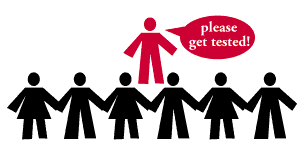|
|
|||||
|
||||||||||||||||||||||||
|
|
|||||||||||||||||||||||||||||||||||||||||||||||||||||||||||||||||||||||
|
|
You can live a healthy life, if you get treatment early. Iron OverloadWhat is iron overload?Iron overload is a serious chronic condition that develops when the body absorbs too much iron over many years and excess iron builds up in organ tissues (for example, heart tissue and liver tissue). What causes iron overload?Iron overload usually occurs as a result of a gene mutation that causes the body to absorb more than a healthy amount of iron. Iron overload less often occurs as a complication of other blood disorders, chronic transfusion therapy, chronic hepatitis, or excessive iron ingestion. Is iron overload dangerous?Yes. Iron overload is dangerous because it can lead to hemochromatosis,
a disease characterized by fatigue,
joint pain, abdominal pain, or organ damage. It can How can I get tested for iron overload?Simple blood tests can measure the iron levels within your body. The tests are inexpensive and can be done at your doctor’s office.
|
||||||||||||||||||||||||||||||||||||||||||||||||||||||||||||||||||||||
 |
"I am one of the lucky ones — I got
treatment in time. But my brother and sister were not so lucky — both
died of liver disease due to iron overload. If their disease had been
diagnosed earlier, they might be alive today. Please get checked if
you think there’s any chance you might have the disease." Jack C. |
This is impossible to answer because children inherit genes from both parents. Talk with your children’s pediatrician about your family history of hemochromatosis. Ask if your children should be tested to make sure their iron levels remain normal.
Indeed, it’s important for all close family members to get their iron levels tested (parents, grandparents, sisters, brothers, and children) if anyone in the family has hemochromatosis.
The earlier family members find out if they have hemochromatosis, the better their chances of leading long, healthy lives.
 |
"We see so many people who find out
too late that they have iron overload — after lots of damage is
already done. It's vital that people with hemochromatosis urge
family members to get tested immediately. Then, if they have the
condition, they can get treatment before there's much damage." Prad Phatak, MD Rochester General Hospital, Rochester, New York |
There is a lot you can do to take charge of hemochromatosis and to make sure your life is as normal and healthy as possible.
 |
Check-ups: Have the amount of iron in your blood tested regularly. |
 |
Phlebotomy: Make sure to get phlebotomies when you need them. |
 |
Food: Don’t eat raw fish or raw shellfish. Cooking destroys germs harmful to people with hemochromatosis. |
 |
Alcohol: If you choose to drink alcohol, drink very little. Women should have no more than one drink a day. Men should have no more than two a day. If you have liver damage, however, do NOT drink any alcohol. |
 |
Iron pills: Don’t take iron pills, supplements, or multivitamin supplements that have iron in them. Eating foods that contain iron is fine. |
 |
Vitamin C: Vitamin C increases the amount of iron your body absorbs. So, don’t take pills with more than 500 mg of vitamin C per day. Eating foods with vitamin C is fine. |
 |
Exercise: You can exercise as much as you want. CDC recommends that everyone should get 30 minutes of exercise a day to stay fit and healthy. |
Yes. There is no medical reason why blood from people with hemochromatosis should not be used for transfusions. The Food and Drug Administration has special guidelines about handling blood donations from people with hemochromatosis.
If you are interested in donating your blood, contact your blood bank directly to find out about its policies.
 |
"For a year now, we've been using blood from the
phlebotomies of hemochromatosis patients for transfusions. The
patients are pleased to help others in this manner, and the practice
has helped greatly in a time of blood shortage." |
In the United States more than one million people have the gene mutation that can cause hemochromatosis; this gene mutation is most common among people whose ancestors came from Europe. Not all people with this gene mutation develop iron overload, and not all people with iron overload develop the clinical signs and symptoms of hemochromatosis.

One of the best things you can do when you find out you have any type of illness is to learn as much as you can about that illness. Talk with your doctor about what to expect. Ask questions.
Sometimes it’s only after you’ve left the doctor’s office that you think of questions. After learning you have hemochromatosis, write your questions down as they come to you, and then talk with your doctor again.
 |
"CDC is interested in teaching blood banks, doctors, and
patients more about early diagnosis and treatment of iron overload.
An important step that patients can take toward good health is to
keep getting phlebotomies." |
Remember, every question is worth asking.
National Human Genome Research
Institute
Information on genetics from the National Institutes of Health for
physicians and nurses.
Iron Disorders Institute*
Iron Disorders Institute (IDI) is a nonprofit National Voluntary Health
Agency whose mission is to reduce pain, suffering, and unnecessary death
by uniting resources to educate the public and medical community about
iron.
You can get on the Internet free at all public libraries.
You can live a long, healthy life when you take charge of your hemochromatosis.
The earlier you get treatment, the better your chances of staying healthy.

 |
"I have iron overload, so I had my son tested to see if he has it too. I'm glad I did because he does have the disease, and we found out early. The doctor says if my son watches what he eats and gets phlebotomies when he needs them, he'll probably never suffer any bad effects." Carol S. |
![]() This site contains documents available in Adobe Acrobat Reader format (PDF). To
view or print them, you must have Adobe Acrobat Reader (version 3.0 or higher)
installed on your computer. You can
download it for
free from Adobe Corporation.
This site contains documents available in Adobe Acrobat Reader format (PDF). To
view or print them, you must have Adobe Acrobat Reader (version 3.0 or higher)
installed on your computer. You can
download it for
free from Adobe Corporation.
*Links to non-Federal organizations are provided solely as a service to our users. Links do not constitute an endorsement of any organization by CDC or the Federal Government, and none should be inferred. The CDC is not responsible for the content of the individual organization Web pages found at this link.
|
|
|
|
| Email this page | |
| Printer-friendly version | |
|
|||||||||||||||||
|
|
|
||||||||||||
|